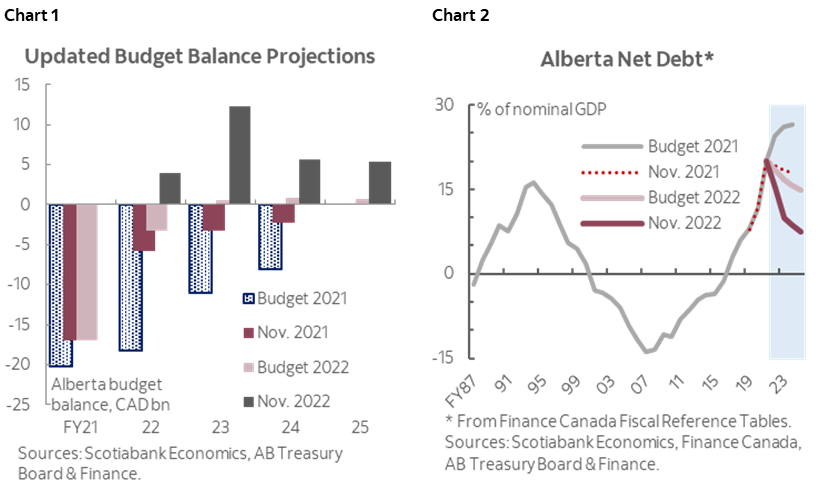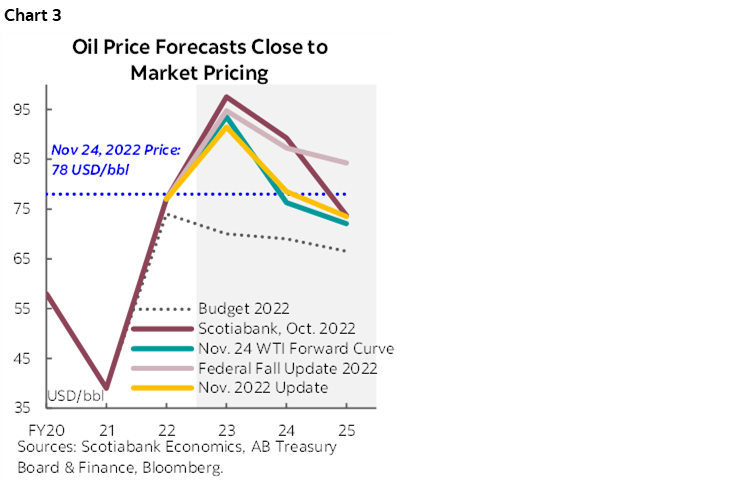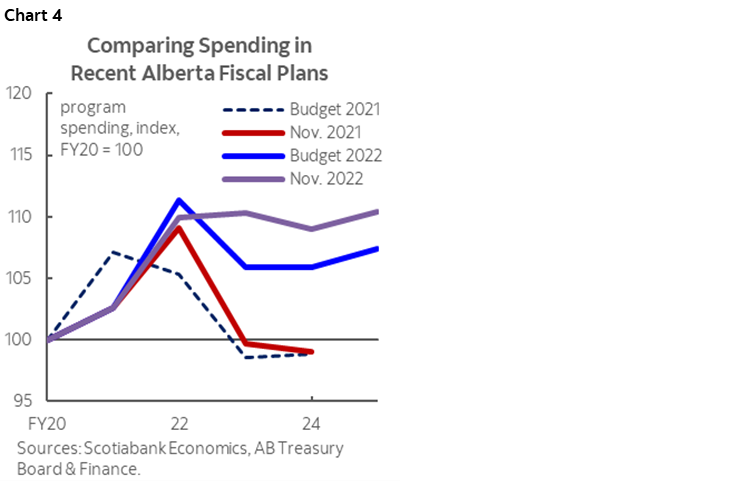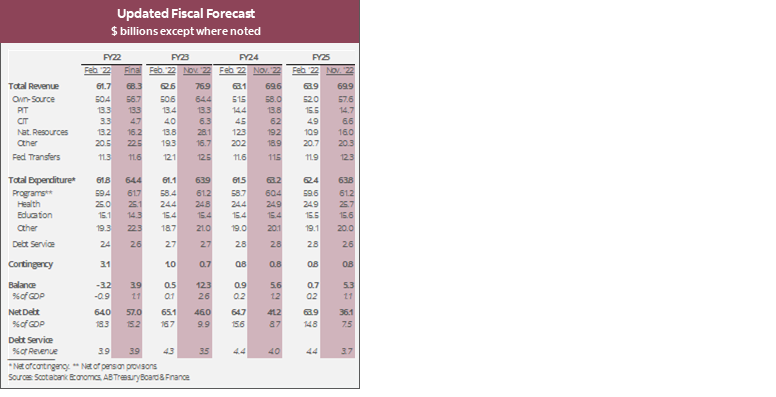FISCAL PRUDENCE IN TIMES OF UNCERTAINTY
- Budget balance forecasts: $12.3 bn (2.6% of nominal GDP) in FY23, $5.6 bn (1.2%) in FY24, $5.3 bn (1.1%) in FY25, respective improvement of $11.8 bn, $4.7 bn, and $4.6 bn versus Budget 2022 (chart 1).
- Net debt: revised down by an average of $23 bn each year through FY25; as a share of nominal output, net debt is now expected to decline steadily from 9.9% in FY23 to 7.5% by FY25 (chart 2).
- Economic forecasts: nominal GDP forecast raised from 11.2% to 24.1% for 2022 but reduced from 6.5% to 1.7% for 2023; WTI price projections lifted to US$91.5/bbl in FY23, US$78.5/bbl in FY24 and US$73.5/bbl in FY25.
- Borrowing requirements: $1.4 bn in FY23, $0.8 bn in FY24, $3.75 bn in FY25, representing a combined FY23–25 reduction of $11 bn from the Budget estimates.
- Capital spending: planned outlays are projected to total $7.6 bn in FY23 and gradually decline to $6.6 bn in FY25—a total of $785 mn increase from Budget 2022 over the three fiscal years, including the $137 mn carried forward from the previous fiscal year according to project progress.
- The updated fiscal plan incorporated the newly-announced affordability package with an estimated cost of $7 bn between FY23 and FY25, which will hit the economy in the coming quarters.
- The Update penciled in modest increases in spending profile and outlined a tentative plan to distribute surplus cash for debt repayment and savings. With the province’s bottom line highly linked to oil prices assumptions, fiscal prudence and conservative planning is largely warranted in an environment of heightened uncertainty. Although the upgraded spending profile remains relatively restrained even with a sizable affordability package built in, we could expect additional spending pressure with an election around the corner next year.

OUR TAKE
As expected, Alberta’s fiscal path saw a material upgrade versus estimates in Budget 2022 back in February, mostly due to the surge in energy prices driven by geopolitical uncertainties. The province is estimating a $12.3 bn surplus for FY23, followed by two years of surpluses of over 1% of nominal output. Planning to use bulk of its cash surplus for debt repayment, the province now expects its net debt-to-GDP ratio to trend on a steep downward path and return to 2019 levels by FY25. Debt servicing costs remain largely unchanged with reduced debt projections offsetting the effect of rising interest rates.
Rising energy prices contribute to the bulk of bottom-line improvements over the planning horizon. Non-renewable resource revenue projection doubled in FY23 versus the Budget, accounting for over 40% of own-source revenue. FY24 and FY25 own-source revenue forecasts were also lifted, with almost all windfalls stemming from resource revenue gains. On the flip side, PIT projection was revised down over the planning horizon, reflecting weakened economic outlook and the indexation of the PIT brackets to inflation (discussed later in the policy section). Own-source revenue is now projected to decline over the three fiscal years, driven by falling non-renewable resource royalties.
Fiscal planning continues to err on the side of caution. The Update assumes WTI price to average US$91.5/bbl in FY23, which is equivalent to assuming an average price of $75 for the rest of the fiscal year, leaving room to cushion recent downward pressure on crude prices. Over the next two fiscal years, WTI price projections are very close to levels suggested by the current pricing of WTI futures, at US$78.5/bbl in FY24 and US$73.5/bbl in FY25. In comparison, the federal government fall update assumes WTI price to average above US$80/bbl over the next three years (chart 3). The province’s fiscal situation is highly tied to oil prices and although the WTI assumptions used in the update seem relatively conservative, there could be some downside risks to the revenue outlook. As every US$1 increase in WTI could lead to $500 mn in revenues according to the Budget’s estimate, to completely offset the surpluses penciled in for FY24 and FY25, WTI would need to average below US$67/bbl in FY24 and US$63/bbl in FY25.

The government is using part of the revenue windfalls to raise spending profile and provide pocketbook relief to households. Total program spending projection saw a slight upgrade versus Budget estimates, raised by $2.5 bn in FY23 and then by $1.7 bn each year in FY24 and FY25—well within the bound of revenue windfalls (chart 4). Overall program spending growth remains restrained over the projection horizon, especially considering the $2.8 bn additional affordability initiatives provision over the three years.

Bulk of new policy measures target cost of living concerns, partially offset the projected revenue gains from FY23 to FY25. Some big-ticket items in the affordability package include the already announced $600 payouts to seniors, middle-income families with dependent children and AISH and PDD receivers, as well as the extension of fuel taxes suspension and electricity rebate. Although relatively sizable with an estimated fiscal impact of $2.6 bn (0.6% of nominal GDP) in FY23 and $2.2 bn (0.5%) in FY24, the affordability measures are fairly substantive with a tilt towards lower- to middle-income households, and the majority of the impact should be short-lived. More permanent changes include indexing personal income tax brackets and income supports to inflation, which has long-term but limited fiscal impact on the province’s bottom line.
The Update outlined a tentative plan to allocate 70–75% of surplus cash to repay taxpayer-supported debt and invest the rest. That means $13.3 bn cash will go into debt repayment in FY23, followed by $2.3 bn in FY24 and $1.4 in FY25. However, this could change as the year unfolds as the government continues to evaluate the trade-offs between debt reduction and increasing savings in an environment of high inflation.
FY23–25 borrowing requirement projections were revised significantly lower than anticipated at Budget time. Due to abundant surplus cash, the province eliminated this year’s planned $2.2 bn government borrowing all together, with the remaining $1.4 bn borrowing requirements dedicated to provincial corporations and GBEs. The borrowing program is now forecast at $825 mn in FY24 and $3.75 bn in FY25.

DISCLAIMER
This report has been prepared by Scotiabank Economics as a resource for the clients of Scotiabank. Opinions, estimates and projections contained herein are our own as of the date hereof and are subject to change without notice. The information and opinions contained herein have been compiled or arrived at from sources believed reliable but no representation or warranty, express or implied, is made as to their accuracy or completeness. Neither Scotiabank nor any of its officers, directors, partners, employees or affiliates accepts any liability whatsoever for any direct or consequential loss arising from any use of this report or its contents.
These reports are provided to you for informational purposes only. This report is not, and is not constructed as, an offer to sell or solicitation of any offer to buy any financial instrument, nor shall this report be construed as an opinion as to whether you should enter into any swap or trading strategy involving a swap or any other transaction. The information contained in this report is not intended to be, and does not constitute, a recommendation of a swap or trading strategy involving a swap within the meaning of U.S. Commodity Futures Trading Commission Regulation 23.434 and Appendix A thereto. This material is not intended to be individually tailored to your needs or characteristics and should not be viewed as a “call to action” or suggestion that you enter into a swap or trading strategy involving a swap or any other transaction. Scotiabank may engage in transactions in a manner inconsistent with the views discussed this report and may have positions, or be in the process of acquiring or disposing of positions, referred to in this report.
Scotiabank, its affiliates and any of their respective officers, directors and employees may from time to time take positions in currencies, act as managers, co-managers or underwriters of a public offering or act as principals or agents, deal in, own or act as market makers or advisors, brokers or commercial and/or investment bankers in relation to securities or related derivatives. As a result of these actions, Scotiabank may receive remuneration. All Scotiabank products and services are subject to the terms of applicable agreements and local regulations. Officers, directors and employees of Scotiabank and its affiliates may serve as directors of corporations.
Any securities discussed in this report may not be suitable for all investors. Scotiabank recommends that investors independently evaluate any issuer and security discussed in this report, and consult with any advisors they deem necessary prior to making any investment.
This report and all information, opinions and conclusions contained in it are protected by copyright. This information may not be reproduced without the prior express written consent of Scotiabank.
™ Trademark of The Bank of Nova Scotia. Used under license, where applicable.
Scotiabank, together with “Global Banking and Markets”, is a marketing name for the global corporate and investment banking and capital markets businesses of The Bank of Nova Scotia and certain of its affiliates in the countries where they operate, including; Scotiabank Europe plc; Scotiabank (Ireland) Designated Activity Company; Scotiabank Inverlat S.A., Institución de Banca Múltiple, Grupo Financiero Scotiabank Inverlat, Scotia Inverlat Casa de Bolsa, S.A. de C.V., Grupo Financiero Scotiabank Inverlat, Scotia Inverlat Derivados S.A. de C.V. – all members of the Scotiabank group and authorized users of the Scotiabank mark. The Bank of Nova Scotia is incorporated in Canada with limited liability and is authorised and regulated by the Office of the Superintendent of Financial Institutions Canada. The Bank of Nova Scotia is authorized by the UK Prudential Regulation Authority and is subject to regulation by the UK Financial Conduct Authority and limited regulation by the UK Prudential Regulation Authority. Details about the extent of The Bank of Nova Scotia's regulation by the UK Prudential Regulation Authority are available from us on request. Scotiabank Europe plc is authorized by the UK Prudential Regulation Authority and regulated by the UK Financial Conduct Authority and the UK Prudential Regulation Authority.
Scotiabank Inverlat, S.A., Scotia Inverlat Casa de Bolsa, S.A. de C.V, Grupo Financiero Scotiabank Inverlat, and Scotia Inverlat Derivados, S.A. de C.V., are each authorized and regulated by the Mexican financial authorities.
Not all products and services are offered in all jurisdictions. Services described are available in jurisdictions where permitted by law.

